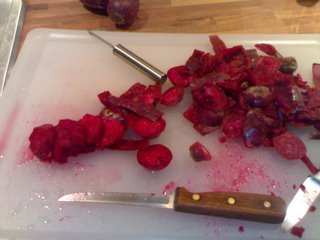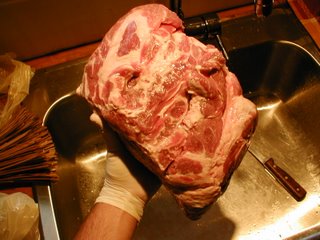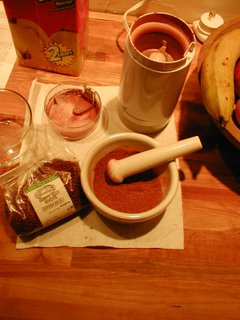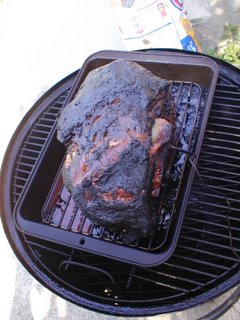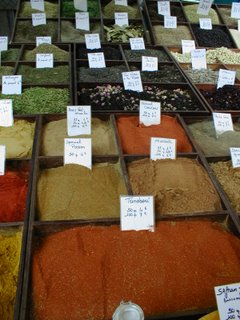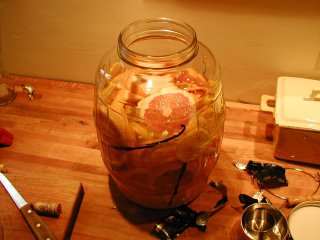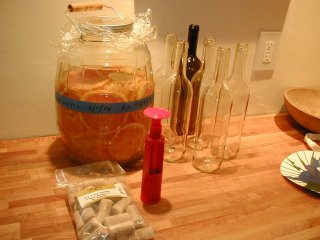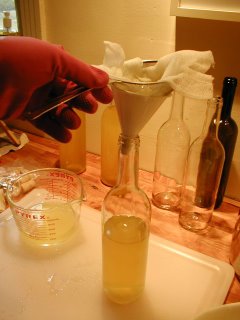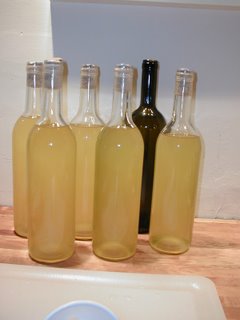This blogging business is hard to keep up with. But the life of the sausage goes on. In the intervening months since the last update we have had our ups and we have had our downs; but mainly we have been having sausage. We vinted the vin d’orange and I am getting ready to start the third batch of bacon.
At the end of March, high off the success of the corned beef, I wanted to do a pastrami. What could be better than corned beef, but a corned beef that is smoked? Hello pastrami.
The process was the same as for the corned beef: Dry rub with salts and spices, cure for five days, then cook. The Charcuterie recipe called for smoking to 150F and finishing it to fork tender by boiling. Again as with the corned beef, I really only wanted to go to 160F and I didn’t want to boil it after smoking. The Virtual Bullet website had a pastrami recipe for smoking to 160f, so why not combine the recipes? It worked last time.
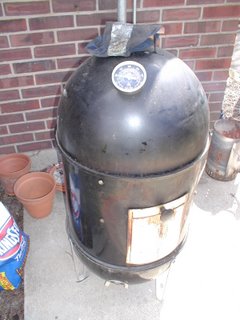
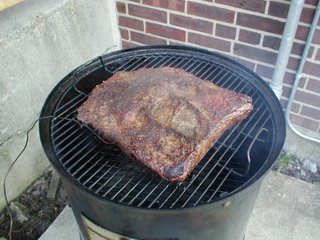
Well it didn’t work, exactly. It got a good smoke, pulled it off at 160F, It looked good, but too salty. And a little chewy. Don’t worry, it got ate, Ruben’s too, but it wasn’t magical like the corned beef. If I were to do it again, I think I would soak it before smoking (to balance the salt) and I would try a finish temp of 175F(give a little more time for fat to render but not dried out). “If” being the operative word here, because smoking it did not do much for me. There were so many subtle favors in the corned beef and they all got lost in the smoke.
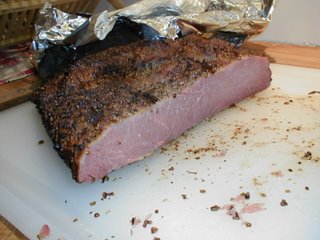

Maybe I should follow a recipe straight. Early April and time to try bratwurst again. This time with veal and added fat back.
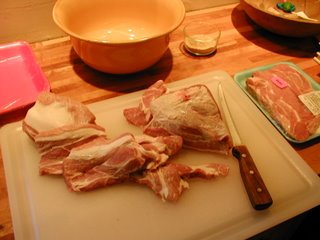
The last couple of times I had made sausage I felt the flavor was good but the texture (mouth feel, for you epicurious types) was not quite right. It seemed a little dry and the added fat should bring a little creaminess to the texture. I didn’t take pictures of the fat back but it was more like fat scraps. Isn’t there some saying about watching sausage being made? Maybe you should go browse the Nordstrom’s website.
Anyway the fat scraps did not fix the mouth feel conundrum, more fine tuning to come.
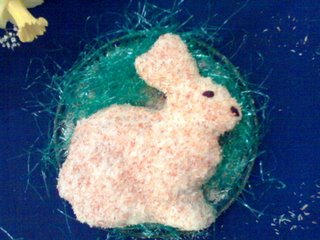
Easter in Columbus, it is nice to have spring sprung, unlike the cold morose in Chicago.
No pictures of the Easter Brunch bacon, but here’s the bunny cake S made. Carrot cake of course. The bacon (second batch) was better that the first, it cooks up nicer and tastes better than any store bought (and only $1.29 a pound). I cured one part of it with maple syrup (sweet), and another part with garlic and picking spices (savory). The sweet turned out great, the savory we can skip next time(see pastrami problems).

Here’s a picture of some fresh pork shoulder. In late April, I made Italian sausage with it. I like to rinse the meat before cubing. But I forgot something. Pat it dry. It made a real mess during the stuffing and the texture was bad (the fat problem from above also contributed). Plus smoke and spices adhere (I don’t mean stick, but penetrate) better to dry meat. I don’t remember where I read that, but just do it, pat it dry.
At this point I am ready for a happy sausage story. Here are my good friends from Williamsburg with their first batch of garlic sausage.



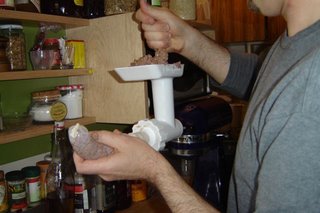


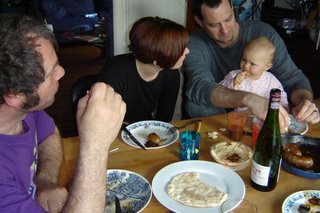
Ah, country living in the heart of the city.
Back home here in the Southland, the South side of Chicago, you know it’s now hip to be from the South side? Working class, gritty and all that, especially since the Pale Hose became the world champs…someday my kids will mockingly say to strangers “Yeah, I grew up on the Southside,” and those strangers, provincial Midwesterners that they will be (Or an immigrant Northsider, as I once was), will shudder in fear, and then a cool breeze of goose pimples will calm the shudder, followed by tiny tingles on the back the neck as they contemplate the coolness of being in the middle of the scrap. No really it’s just the suburbs, just South.
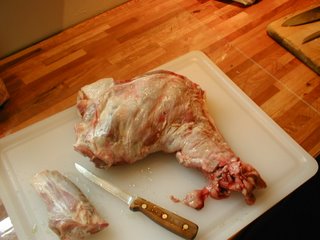
Anyway, earlier in May, I picked up a lamb shoulder for an attempt at Merguez (recipe from Charcuterie). According to the recipe, it is a spicy sausage of North African roots. I love kabobs, so I figured what could be better than a lamb and vegetables stuffed into a sausage. Lamb shoulder, roasted red peppers , garlic, oregano, paprika and fat. Oh yeah, the fat. After some ruminating and some reading I bought some pork jowl.

 The jowl, or the cheek (sorry no quick links to Nordstrom) has the look of bacon but the fat should have a softer texture. I was offered the jowl with the skin removed which was fine, less work. While researching the jowl I came across a preparation called guanciale; certainly a project for the fall when the curing room (read basement) is at the right temperature.
The jowl, or the cheek (sorry no quick links to Nordstrom) has the look of bacon but the fat should have a softer texture. I was offered the jowl with the skin removed which was fine, less work. While researching the jowl I came across a preparation called guanciale; certainly a project for the fall when the curing room (read basement) is at the right temperature.


Well the Merguez turned out nice, I didn’t think the flavor was very exotic, but the texture was perfect, the jowl is the way to go. Here we are enjoying our Arabian Nights. S made the Hummus, I can never do it right. Regarding hummus, if you have the where-with-all, you should make it at home starting with dried chickpeas instead of canned. It makes a big difference.
Finally in the big catch-up posting, lets talk ham. Over Memorial day weekend I roasted a fresh ham on the Weber SM.
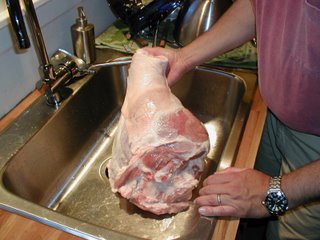 Fresh ham means not the deli meat but the back leg of a pig, uncured. Ever since I first saw them stacked nine or ten high in the meat case, I wanted to cook one. It would be like a mini luau, or any other given pig roasting experience of the tropics or the Mediterranean. I didn’t have a recipe and the internet did not have a lot of ideas.
Fresh ham means not the deli meat but the back leg of a pig, uncured. Ever since I first saw them stacked nine or ten high in the meat case, I wanted to cook one. It would be like a mini luau, or any other given pig roasting experience of the tropics or the Mediterranean. I didn’t have a recipe and the internet did not have a lot of ideas.
I liked the idea of the Italian Porchetta, so I spiked it with rosemary and garlic, before that I brined it for about 10 hours, and before that, I guess that is when I bought it, I picked the smallest one in the case and it came to 17 pounds.
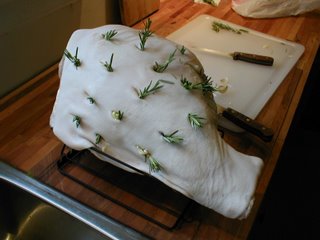
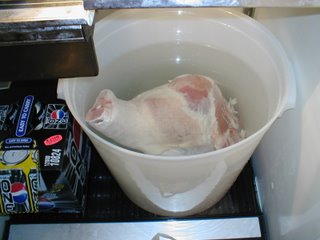
I decided to try a roasting temp of 350, my reasoning being, that I wanted a higher temp to get the skin crackling, and I had success smoking turkeys at that temperature. I cooked the ham for about 6 hours to an internal temp of 155.
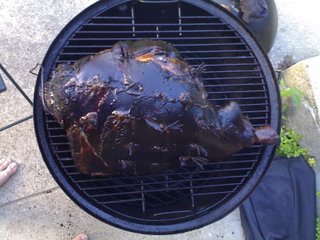
The results were mixed. The high temp caused the on the outside to get dried out while closer to the bone was perfect. I didn’t brine it long enough, should be 18 to 24 hours. I am not deterred, the ham roast is a good summer party item, especially with the garlic an rosemary that reminds me……Italy several summers ago rolling though the countryside in our little Opel, stumbling into tiny towns on market days. The markets consisted or 3 or four trucks; one of those trucks was always a pork van. Gimmie one grassa. Oh baby, on an unsalted roll a slab of meat smeared with a pumice of salt, pepper, rosemary and olive oil. Simple, sun hot afternoon, wash is down with a bubbly water.
Cheers.
Thanks to everyone who sent comments, for those who tried but couldn't get through, try again, I fliped a few switches, I'll get this blogging stuff figured out sooner or later.

